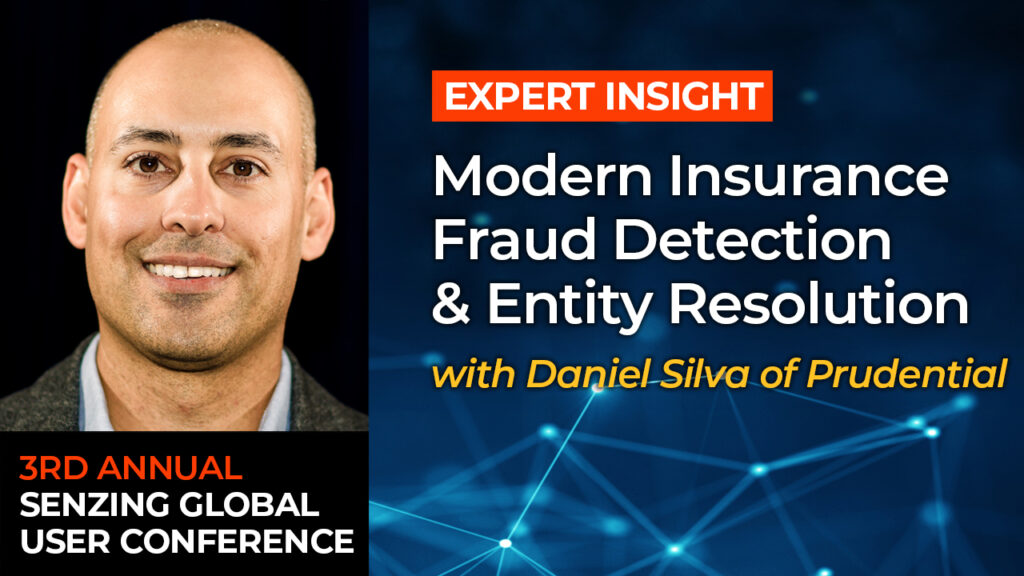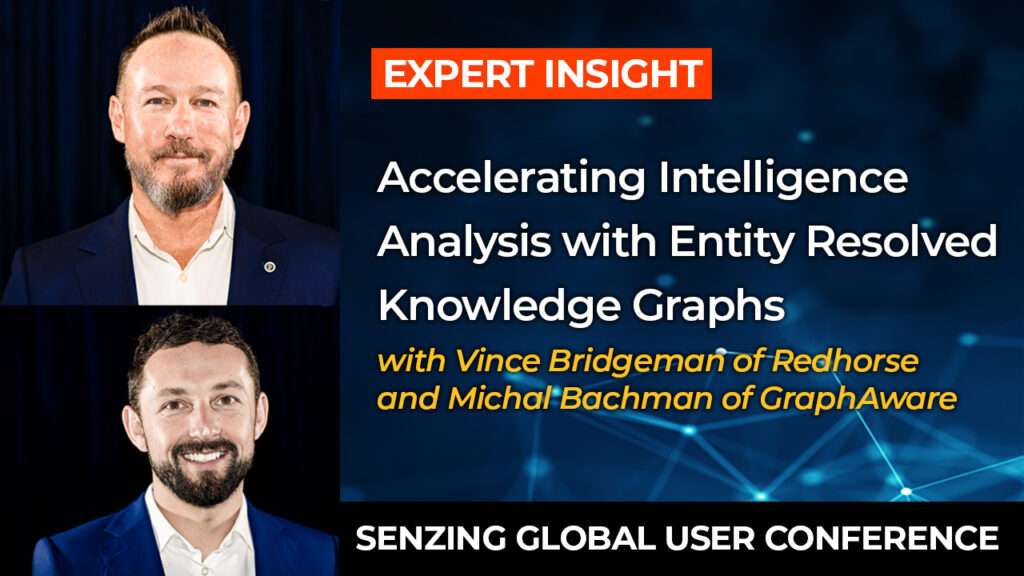Daniel Silva of Prudential
Discusses Insurance Fraud Detection
At Senzing Global User Conference
“We’re no longer trying to stay 10 steps ahead of the criminals – we’re trying to stay ahead of the machines. It’s machine versus machine at this point,” declares Daniel Silva, director of data analytics at Prudential, addressing the audience at the Senzing 2024 Global User Conference. His assessments cut to the heart of why traditional fraud prevention approaches need to evolve to meet today’s challenges in the life insurance and annuity sectors.
Silva, who also serves as a board member for the Institute of Data Science at New Jersey Institute of Technology (NJIT), has deep expertise in financial fraud detection and data analytics. In his presentation, he illuminates how the complexity of insurance products, combined with legacy data systems and emerging AI threats, creates unique challenges for modern-day fraud prevention.
The Complex Web of Insurance Data
Silva explains that understanding fraud in the insurance space requires first understanding the life insurance products themselves. He demonstrates how even a basic life insurance policy creates a complex network of relationships. Each policy involves multiple entities – policy owner, insured and beneficiaries – that must be carefully tracked and verified.
The challenge becomes even more complex when dealing with legacy data. Prudential faces unique data hurdles as a company celebrating 150 years in operation. Among the challenges is ensuring legitimate beneficiaries from new and existing policies receive their intended benefits while preventing fraud.
To address these challenges, Prudential has implemented comprehensive verification systems that use a multi-layered approach to help establish what Silva calls “business truth” in an increasingly complex data environment.
Three Faces of Insurance Fraud
Silva breaks down insurance fraud into three distinct categories, each requiring different detection approaches:
- Internal Fraud: Employee account takeovers and disbursement redirections pose a significant threat. Silva describes a recent federal case in which an employee of an international financial institution identified high-net-worth clients, changed the contact email addresses to his and created false paper trails to steal funds. To combat this, Prudential monitors patterns and restricts employee access to high-net-worth accounts.
- Client Fraud: This includes schemes like opening multiple policies under slightly different names or identity swapping. With the introduction of online underwriting, fraudsters can more easily circumvent underwriting thresholds. Prudential now has systems in place to identify these attempts.
- External Fraud: Account takeovers by external actors have become more sophisticated. Today, bad actors leverage stolen credentials, social engineering to figure out where you work or go to school, and even AI-generated voice samples to defeat security measures. Prudential’s defense includes analyzing information, identifying temporary cell numbers and monitoring fax numbers used for document submission.
The Data Challenge: Legacy and Siloed Systems
For established insurers, the data infrastructure itself can become an obstacle to fraud detection. Having data in multiple places can make it harder to spot patterns and identify suspicious activity across products and services.
Prudential processes multiple unique record changes monthly, and each change introduces new data that must be resolved and verified. To manage this constant flow of updates, Prudential must validate and connect information across disparate systems while maintaining regulatory compliance and data privacy requirements.
The Rise of AI-Powered Threats
The emergence of AI and machine learning has sparked a new urgency to intensify fraud prevention efforts. Silva details how fraudsters are now using AI to systematically harvest security questions from financial institutions and generate convincing voice samples to bypass authentication.
The threat extends beyond voice authentication. Criminals are using AI for credential-stuffing attacks, where machine learning systems attempt to identify patterns in security questions and responses. This has led to a new arms race in the financial sector, where institutions must deploy their own AI systems to detect and prevent these automated AI-powered attacks.
A Modern Defense: Entity Resolution and Real Time Analysis
This evolving threat landscape makes real time entity resolution crucial. “As a new entity is being introduced into the system, you need to really quickly understand who they are,” Silva emphasizes. Prudential’s approach combines traditional verification methods with sophisticated systems that can identify suspicious combinations of addresses, phone numbers and social security numbers across its various platforms in real time.
The company also uses entity resolution systems to maintain accurate contact information for beneficiaries beyond just their name so benefits reach the intended recipients. By easily resolving data across multiple data sources, Prudential can maintain accurate beneficiary information even as circumstances change over decades.
By understanding the complex relationships between entities in real time, insurers can better detect and prevent fraud before significant losses occur. Technology like Senzing entity resolution can provide the foundation for successfully addressing these challenges, helping companies like Prudential maintain their commitment to protecting customers while adapting to new threats.
In his presentation, Silva makes it clear that successful fraud prevention in today’s insurance industry requires a sophisticated understanding of both traditional insurance products and emerging technologies. As fraudsters deploy ever-more advanced tools, the industry must evolve its approach to data management and fraud detection while maintaining its fundamental promise to protect customers’ financial security.
Video Highlights
00:42 Understanding insurance policy structure and relationships
Each policy creates a complex web of relationships between owners, insured individuals and beneficiaries, with each connection point presenting unique vulnerabilities to fraud.
04:13 The impact of identity theft on customers
Outdated company policies with minimal documentation create a perfect storm: companies must verify identities and prevent fraud while ensuring legitimate beneficiaries don’t lose their rightful benefits.
06:18 Internal fraud schemes and employee misconduct
Employee fraud often targets high-net-worth clients through a methodical process: identify wealthy customers, alter their contact information and create false paper trails to legitimize fund transfers.
9:48 Modern digital fraud techniques
Online policy applications have enabled new forms of fraud, with criminals using multiple slightly altered identities to circumvent underwriting thresholds and verification systems.
12:38 Data collection and verification challenges (external fraud)
Modern identity thieves combine stolen personal information with social engineering to take over accounts, often targeting policies with multi-million-dollar values.
18:09 Entity resolution for complex organizations
Regulatory requirements often prevent different business units from sharing databases, creating blind spots that sophisticated fraudsters can exploit.
24:00 Entity resolution in an AI world
Today’s fraudsters harvest security questions and answers systematically, building comprehensive profiles to defeat traditional authentication measures.
26:22 Real time entity resolution for fraud detection systems
Modern fraud prevention requires real time analysis of relationships between entities, identifying suspicious patterns before losses occur.




